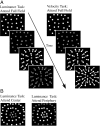Impact of early deafness and early exposure to sign language on the cerebral organization for motion processing
- PMID: 11698604
- PMCID: PMC6762265
- DOI: 10.1523/JNEUROSCI.21-22-08931.2001
Impact of early deafness and early exposure to sign language on the cerebral organization for motion processing
Abstract
This functional magnetic resonance imaging study investigated the impact of early auditory deprivation and/or use of a visuospatial language [American sign language (ASL)] on the organization of neural systems important in visual motion processing by comparing hearing controls with deaf and hearing native signers. Participants monitored moving flowfields under different conditions of spatial and featural attention. Recruitment of the motion-selective area MT-MST in hearing controls was observed to be greater when attention was directed centrally and when the task was to detect motion features, confirming previous reports that the motion network is selectively modulated by different aspects of attention. More importantly, we observed marked differences in the recruitment of motion-related areas as a function of early experience. First, the lateralization of MT-MST was found to shift toward the left hemisphere in early signers, suggesting that early exposure to ASL leads to a greater reliance on the left MT-MST. Second, whereas the two hearing populations displayed more MT-MST activation under central than peripheral attention, the opposite pattern was observed in deaf signers, indicating enhanced recruitment of MT-MST during peripheral attention after early deafness. Third, deaf signers, but neither of the hearing populations, displayed increased activation of the posterior parietal cortex, supporting the view that parietal functions are modified after early auditory deprivation. Finally, only in deaf signers did attention to motion result in enhanced recruitment of the posterior superior temporal sulcus, establishing for the first time in humans that this polymodal area is modified after early sensory deprivation. Together these results highlight the functional and regional specificity of neuroplasticity in humans.
Figures







References
-
- Ahlfors SP, Simpson GV, Dale AM, Belliveau JW, Liu A, Korvenoja A, Virtanen J, Huotilainen M, Tootell RBH, Aronen HJ, Ilmoniemi RJ. Spatiotemporal activity of a cortical network for processing visual motion revealed by MEG and fMRI. J Neurophysiol. 1999;82:2545–2555. - PubMed
-
- Allison T, Puce A, McCarthy G. Social perception from visual cues: role of the STS region. Trends Cogn Sci. 2000;4:267–278. - PubMed
-
- Beauchamp M, Cox R, DeYoe E. Graded effects of spatial and featural attention on human area MT and associated motion processing areas. J Neurophysiol. 1997;78:516–520. - PubMed
-
- Bosworth R, Dobkins K. Left hemisphere dominance for motion processing in deaf signers. Psychol Sci. 1999;10:256–262.
Publication types
MeSH terms
Grants and funding
LinkOut - more resources
Full Text Sources
Medical
